Abstract
Five new cembrane-type diterpenes, lobocalines A–E (1–5), and four new steroids, lobocaloids A–D (9–12), along with six known related compounds (6–8 and 13–15) were isolated from the Yalong Bay soft coral Lobophytum catalai Tixier-Durivault. The structures of the new compounds were elucidated by extensive spectroscopic analysis, NMR calculation with DP4+ analysis, time-dependent density functional theory–electronic circular dichroism (TDDFT-ECD) calculations, X-ray diffraction analyses and comparison with the reported spectroscopic data of known compounds. Further, with the aid of X-ray diffraction analysis, the structure of lobocrasol B (15) was firmly revised as 15a. In in vitro bioassays, compound 2 showed moderate antibacterial activities against fish pathogenic bacteria Streptococcus parauberis KSP28 and Phoyobacterium damselae FP2244 with minimum inhibitory concentration (MIC) values of 8.7 and 17.3 µg/mL, respectively. All the steroids exhibited antibacterial activities against the S. parauberis KSP28 with MIC values ranging from 12.3 to 53.6 µg/mL. Compounds 2, 7 and 14 have remarkable inhibitory effects on the hemolysin production of Staphylococcus aureus, while compounds 8–12 have medium inhibitory effects on the pyocyanin production in Pseudomonas aeruginosa.
1. Introduction
Aquaculture is a crucial component of agriculture, the foundational element of agricultural economic growth and a crucial source of food. With the rapid and intensive development of aquaculture, many problems related to aquatic animal diseases have gradually been exposed. The main pathogens of aquatic animals include bacteria, viruses, parasites, etc. It is estimated that economic loss of aquatic animals caused by numerous bacteria (such as Streptococcus parauberis and Aeromonas salmonicida) accounts for 58%, which is the most serious factor leading to the economic loss of aquaculture [1,2,3]. As antibiotic resistance and drug residues in aquaculture have become global focus, the search for new and effective antibacterial compounds against fish pathogenic bacteria has become more important and urgent. In addition, bacteria Staphylococcus aureus and Pseudomonas aeruginosa could also cause a broad range of life-threatening diseases in humans. For example, S. aureus cause infectious disease by the production of virulence factors such as hemolysins [4]. Pyocyanin, the secondary metabolite produced by P. aeruginosa, is considered to play an essential role of oxidative stress in the infection [5].
Marine invertebrates are important sources of natural products and have been recognized to be the rich source of bioactive secondary metabolites with structural diversity [6,7,8,9,10]. Therefore, the marine invertebrates have enormous potential for exploring new marine drugs. In particular, soft corals of the genus Lobophytum (order Alcyonacea, family Alcyoniidae) have become an intensive research subject, which produced varieties of structurally intriguing and biologically interesting molecules [11,12]. More recently, two breakthrough studies have been reported toward the biosynthesis of terpenes in the soft corals and the identification of coral-encoded terpene cyclase genes enabled the enzyme that construct the coral-exclusive terpene scaffolds [13,14], which attract significant attentions to conduct the metabolic patterns of marine soft coral metabolites. In addition, a survey of the extensive literature revealed that abundant Lobophytum soft corals are inhabiting in the South China Sea, and the titled species L. catalai has been rarely studied. Until now, only a total of four studies have been reported on the chemical investigations of this species, leading to the discovery of several terpenes [15,16,17] and steroids [18] with anti-inflammatory [17] and/or cytotoxic [17] activities.
In the course of our continuing effort to explore chemically fascinating and biologically active secondary metabolites of South China Sea marine invertebrates [12], we recently carried out a chemical investigation on the soft coral L. catalai collected off Yalong Bay, Hainan Province, China, resulting in the isolation and characterization of nine new compounds, namely lobocalines A–I (1–5 and 9–12), together with six known compounds (6–8 and 13–15) (Figure 1). The structural difference between the five new diterpenes 1–5 is reflected in the different positions of substituents. Moreover, the structural diversities of six steroids 9–14 are mainly attributed to the different configurations of C-5 and C-6 in ring B of steroidal nucleus and the variations in functional groups on the side chains. What is more is that the structural determinations of new compounds are also a challenging problem, and X-ray diffraction analysis as a powerful tool [19] was applied in this study. Herein, we report the detailed isolation, planar structural elucidation, stereochemistry determination, and antibacterial activity evaluation of these isolated compounds.
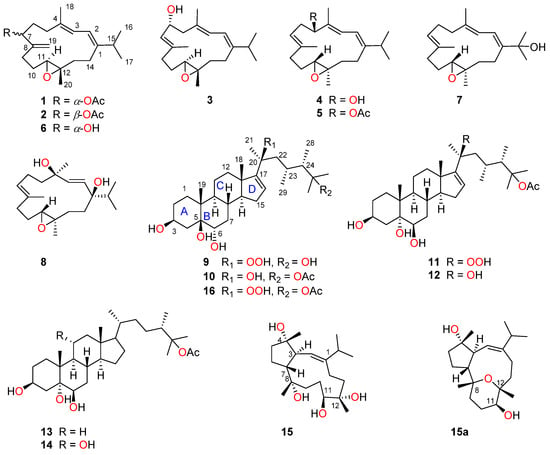
Figure 1.
Chemical structures of compounds 1–16.
2. Results
Samples of L. catalai were frozen immediately to –20 ℃ after collection and stored at that temperature before they were exhaustively extracted by acetone. The Et2O-soluble portion of the acetone extract was subjected to repeated column chromatography (CC) (silica gel, Sephadex LH-20 and reversed-phase HPLC) to yield five new cembrane-type diterpenes lobocalines A–E (1–5) and four new steroids lobocaloids A–D (9–12), along with six known analogues (6–8 and 13–15). The known compounds were rapidly characterized as sarcoboettgerol D (6) [20], 11,12-epoxy-1E,3E,7E-cembratrien-15-ol (7) [21], sarcophytrol L (8) [22], 24ξ-methylcholestane-3β,5α,6β,25-tetrol-25-monoacetate (13) [23], acutumosterol B (14) [24], and lobophytrol B (15) [25], respectively, by the comparison of their NMR data and optical rotation [α]D values with those reported in the literature.
Compound 1, namely lobocaline A, was isolated as colorless crystals and gave the molecular formula of C22H34O3 as established by HRESIMS from the protonated molecular ion peak observed at m/z 347.2580 [M + H]+ (calcd. for C22H35O3, 347.2581), implying six degrees of unsaturation. The characteristic peak at νmax 1737 cm−1 in its IR spectrum showed the presence of ester carbonyl group, which was further confirmed by the diagnostic 13C NMR chemical shift at δC 170.6. The 1H and 13C NMR data (Table 1 and Table 2) of 1 along with the assistance of DEPT spectrum revealed the presence of two trisubstituted double bonds [δH 6.06 (1H, d, J = 10.8 Hz, H-2), δC 118.6 (CH, C-2) and 146.9 (qC, C-1); δH 5.97 (1H, d, J = 10.9 Hz, H-3), δC 135.1 (qC, C-4) and 121.7 (CH, C-3)], one exocyclic double bond [δH 5.15 (1H, s, H-19) and δH 5.18 (1H, s, H-19), δC 146.8 (qC, C-8) and 113.0 (CH2, C-19)] and one epoxy ring [δH 2.86 (1H, dd, J = 7.5, 4.6Hz), δC 61.0 (CH, C-11) and δC 61.6 (qC, C-12)]. The above-mentioned moieties accounted for five of the six degrees of unsaturation, indicating the monocyclic carbon framework for 1. A comparison of the NMR data of 1 with those of the co-occurring known compound sarcoboettgerol D (6), which had been recently isolated from soft coral Sarcophyton boettgeri and its absolute configuration was determined by the TDDFT-ECD calculation method [20], which revealed that they were structural analogues, with the only difference being that the hydroxyl group at C-7 in 6 was substituted by an acetyloxy group at C-7 in 1, in agreement with the 42 mass unit difference in their molecular weights. The position of the acetyloxy group at C-7, as evidenced by the observation of the upfield shift of C-6 from δC 32.9 in 6 to δC 30.0 in 1. This assignment was further confirmed by strong HMBC correlations (Figure 2) from H-7 (δH 5.16) to C-19 (δC 113.0), C-8 (δC 146.8) and carbonyl carbon (δC 170.6). Thus, the planar structure of 1 was determined as shown in Figure 2.

Table 1.
1H data of compounds 1–5 in CDCl3.

Table 2.
13C (150 MHz) data of compounds 1–5 in CDCl3.
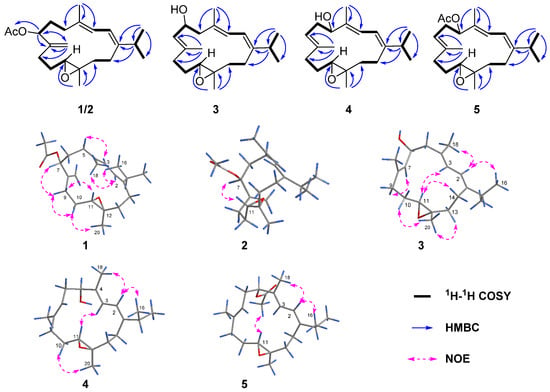
Figure 2.
The 1H–1H COSY, selected key HMBC and ROESY correlations of compounds 1–5.
The relative configuration of 1 was established mainly by the analysis of NOESY correlations (Figure 2). The clear NOE correlations of H-2 (δH 6.06)/H3-16 (δH 1.10), H-2/H3-18 (δH 1.78) and H-3 (δH 5.97)/H-5α (δH 2.24) indicated the “1E, 3E” geometry of the two double bonds Δ1,2 and Δ3,4. The highly similar NOE correlations of H-7/H-9β, H-9β/H-10β and H-10β/H3-20 and H-9α/H-11 between compounds 1 and 6 suggested that these two compounds shared the same stereochemistry. Furthermore, the suitable single crystals of 1 in MeOH were obtained. The X-ray crystallographic analysis using Cu Kα radiation (λ = 1.54178 Å) firmly disclosed the absolute configuration of 1 to be 7R, 11S, 12S with the Flack parameter of 0.00 (10) (Figure 3, CCDC 2290865). What is more is the acetylation of 6 yielding 1 further confirmed the structure and stereo-configuration of 1. The chemical structure of 1 was thus established as shown in Figure 1.
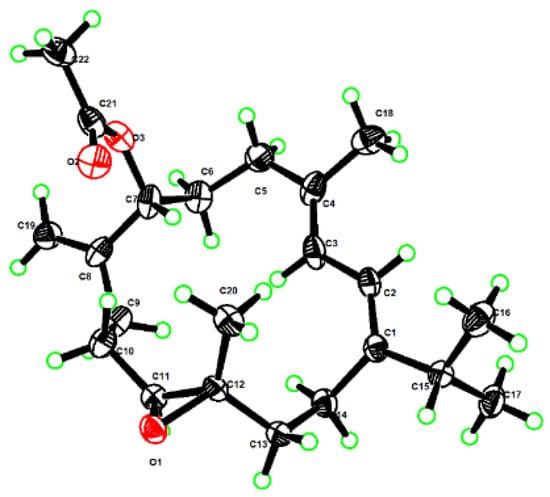
Figure 3.
Perspective ORTEP drawing of the X-ray structure of 1 (Carbon atoms are represented by black ellipsoids, oxygen atoms are represented by red ellipsoids, and hydrogen atoms are represented by green spheres).
Lobocaline B (2), a colorless oil, gave the same molecular formula as 1 on basis of its HRESIMS ion peak at m/z 347.2581 [M + H]+ (calcd. for C22H35O3, 347.2581). Overall, the 1H and 13C NMR data of 2 (Table 1 and Table 2) were reminiscent of 1. Careful comparison of their NMR data revealed they possessed the same planar structure and only chemical shifts at C-7 (δC 72.5 in 1 vs. δC 75.9 in 2) were different, suggesting that 2 was simply the C-7 epi-isomer of 1, thus suggesting the assignment of 7S*, 11S*, 12S* configuration of 2. Further analysis of 2D NMR spectra and the obvious NOESY correlations of H-7/H-11 confirmed this hypothesis (Figure 2). Subsequently, the absolute configuration of 2 was then assigned to be 7S, 11S, 12S by the comparison of similar experimental ECD spectra of compounds 1 (Figure S1.9) and 2 (Figure S2.9). Accordingly, the structure of 2 was determined as depicted in Figure 1.
Lobocaline C (3) was isolated as a colorless oil, and its molecular formula was assigned as C20H32O2 by HRESIMS ion peak at m/z 327.2295 [M + Na]+ (calcd. for C20H32O2Na, 327.2295), indicating five degrees of unsaturation. The 1D NMR data of 3 (Table 1 and Table 2) showed great similarities to those of lE,3E,7E,11:12-epoxy-l,3,7-cembratriene, a known cembranoid isolated from the South Andaman Coast soft coral Lobophytum sp. [26], with the only difference being the presence of an additional hydroxyl group at C-6 in 3, in agreement with the 16 mass unit difference between these two compounds. This assignment was further confirmed by the strong 1H–1H COSY correlations of H-6 (δH 4.54)/H-7(δH 5.30) (Figure 2). As mentioned above, the planar structure of 3 was determined as shown in Figure 2. The geometries of the double bonds at Δ1,2, Δ3,4 and Δ7,8 were both assigned to be E by the NOESY correlations of H-2 (δH 5.94)/H3-16 (δH 1.05), H-2/H3-18 (δH 1.78) and H-7 (δH 5.30)/H-9α (δH 2.30) (Figure 2), respectively. The relative configurations of C-11 and C-12 in 3 were proven to be the same as those of 1 due to the diagnostic NOESY correlations of H3-20 (δH 1.25)/H-10b (δH 1.46), H3-20/H-13b (δH 2.00), H-11 (δH 2.82)/H-3 (δH 5.92) and H-11/H-14a (δH 2.36). To figure out the relative configuration of 3, the QM-NMR calculation was performed to give the best match of more than 99% probability in DP4+ with the 6R*, 11S*, 12S* isomer (see the details in the Supplementary Materials). The absolute configuration of 3 was determined by time-dependent density functional theory (TDDFT) ECD calculation. The theoretical ECD spectrum of 3 was calculated by the DFT method at the B3LYP/6-311G(d,p) level. As a result, the Boltzmann-averaged ECD spectrum of (6R, 11S, 12S)-3 highly matched the experimental ECD spectrum of 3, while the calculated ECD spectrum of enantiomer showed a completely opposite curve (Figure 4). Consequently, the absolute configuration of 3 was established to be 6R, 11S, 12S.
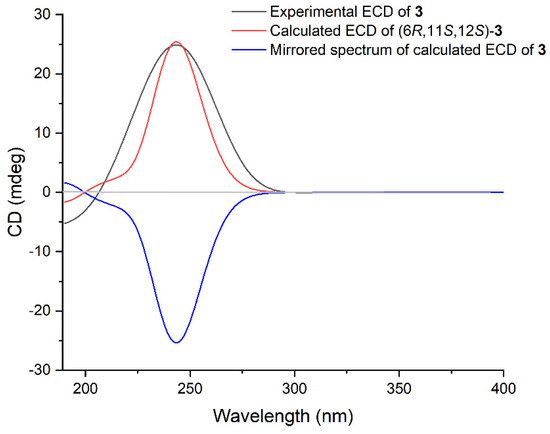
Figure 4.
Experimental ECD spectrum of 3 (black), calculated ECD spectra of the enantiomers (6R, 11S, 12S)-3 (red) and (6S, 11R, 12R)-3 (blue).
Lobocaline D (4), a colorless oil, has the same molecular formula (C20H32O2) as that of 3, implying they are isomers. Comparison of 1H and 13C chemical shifts of 4 and 3 (Table 1 and Table 2) followed by a detailed analysis of 2D NMR data revealed that the structure of 4 was similar to that of 3 with a different substituted position of the hydroxyl group. This conclusion was further supported by HMBC correlations from H3-18 (δH 1.74) to C-5 (δC 78.1) and 1H–1H COSY correlations of H-5 (δH 4.12)/H-6α (δH 2.39)/H-7 (δH 5.19). Thus, the planar structure of 4 was determined. The relative configurations of C-11 and C-12 in 4 were assigned to be the same as those of 1 due to the similar 13C NMR data. Similarly, the relative configuration of 4 was also elucidated via QM-NMR calculations using the DP4+ protocol. The best match was observed for the 5R*, 11S*, 12S* relative configuration with a DP4+ probability over 99%. Moreover, the absolute configuration of 4 was further determined by the TDDFT-ECD approach. As shown in Figure 5, the Boltzmann-averaged ECD curve calculated for the (5S, 11R, 12R)-4 enantiomer matched very well with the experimental ECD spectrum of 4. Accordingly, the absolute configuration of 4 was determined to be 5S, 11R, 12R.
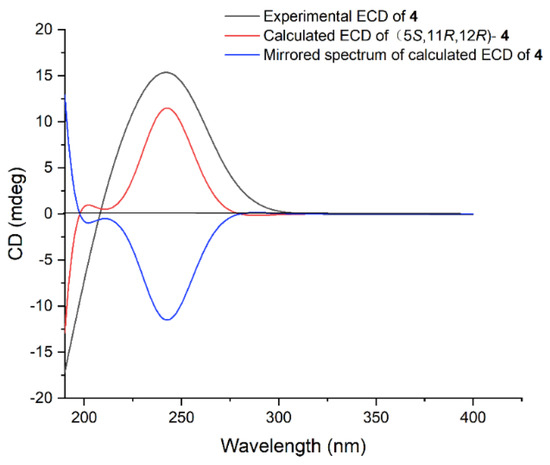
Figure 5.
Experimental ECD spectrum of 4 (black), calculated ECD spectra of the enantiomers (5S, 11R, 12R)-4 (red) and (5R, 11S, 12S)-4 (blue).
Lobocaline E (5) was obtained as a colorless oil. Its molecular formula, C22H34O3, was deduced from the ion peak observed at m/z 369.2397 [M + Na]+ (calcd. for C22H34O3Na, 369.2400) in its HRESIMS spectrum. The 1H and 13C NMR data (Table 1 and Table 2) of 5 were extremely similar to those of the co-occurring compound 4, indicating that they are structural analogues. In fact, the only difference between these two compounds is the replacement of the hydroxyl group at C-5 in 4 by the acetyl group at C-5 in 5, in agreement with the 42 mass unit difference between compounds 4 and 5. To determine the relative configuration of 5, the theoretical and experimental NMR data were correlated and their corresponding DP4+ probabilities were estimated. Consequently, the candidate structure 5a (Figure S11.3) showed the dominant probability of 99.52%, indicating the 5R*, 11S*, 12S* relative configuration of 5. In this case, the TDDFT-ECD calculation was also employed to determine the absolute stereochemistry of 5. As shown in Figure 6, the calculated ECD spectrum of (5S, 11R, 12R)-5 fairly matched with the experimental one, allowing us to assign the absolute configuration of 5 to be 5S, 11R, 12R. Moreover, the hydrolysis reaction of 5 was also performed, but unfortunately, no product was detected due to the low number of isolated compounds. The chemical structure of 5 was thus established as depicted in Figure 1.
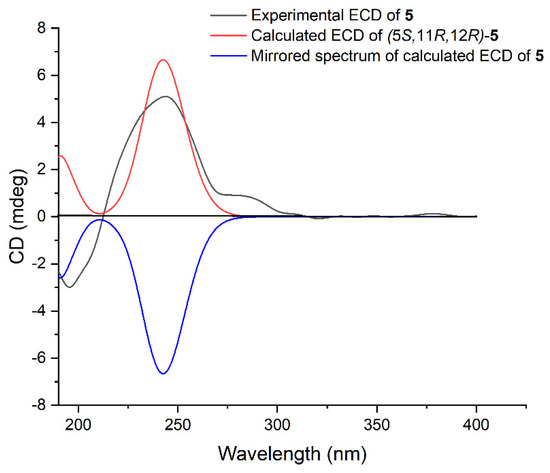
Figure 6.
Experimental ECD spectrum of 5 (black), calculated ECD spectra of the enantiomers (5S, 11R, 12R)–5 (red) and (5R, 11S, 12S)–5 (blue).
Lobocaloid A (9) was isolated as a white powder. Its molecular formula was determined as C29H50O6 by HRESIMS m/z 517.3504 [M + Na]+ (calcd. for C29H50O6Na, 517.35), appropriate for five degrees of unsaturation. The 1H NMR data of 9 (Table 3) showed the general characters of polyhydroxylated sterols, including an olefinic proton resonating at δH 5.70 (1H, dd, J = 3.5, 1.5 Hz, H-16), two oxymethines at δH 4.27(1H, s, H-3), 3.82 (1H, dd, J = 12.2, 4.9 Hz, H-6), a hydroperoxyl group signal at δH 9.20 (br s), and seven methyls at δH 0.94 (3H, s, Me-18), 0.95 (3H, s, Me-19), 1.30 (3H, s, Me-21), 1.20 (3H, s, Me-26), 1.19 (3H, s, Me-27), 0.86 (3H, d, J = 7.3 Hz, Me-28), 0.93 (3H, d, J = 7.1 Hz, Me-29). Moreover, the 13C NMR data (Table 3) and DEPT spectrum of 9 indicated the presence of 29 signals, which comprised seven methyls, eight methylenes, eight methines (including one olefinic at δC 126.9, and seven sp3 hybridized at δC 67.9, 72.0, 32.5, 43.5, 58.0, 30.2, 50.3) and six quaternary carbons (including an olefinic at δC 158.3 and five sp3 hybridized at δC 78.2, 41.3, 47.5, 85.7, 75.6). These above data suggest the presence of a trisubstituted double bond, which accounted for one degree of unsaturation. The remaining four degrees of unsaturation were attributed to a tetracyclic system in the molecule. In the 1H–1H COSY spectrum, it was possible to identify three different structural units extending from C-1 to C-4; from C-6 to both C-12 and C-16 through C-8; and from C-22 to both C-28 and C-29 through C-23 (Figure 7). From the HMBC spectrum, the correlations from H3-19 to C-1, C-5, C-9 and C-10; from H3-18 to C-12, C-13, C-14 and C-17; from H-6 to C-4 and C-5; from H-16 to C-20; from H3-21 to C-17, C-20 and C-22; from both H3-26 and H3-27 to C-24; and from H3-28 to C-25 permitted the establishment of the carbon skeleton of a 23,24-dimethycholestane (Figure 7). The hydroperoxyl group substituted at C-20 was confirmed by the HMBC correlation of the hydroperoxyl proton δH 9.20 (br s) to the oxygenated carbon at δC 86.1 (C-20). An extensive survey of the literature revealed that the structure of 9 closely resembled that of michosterols A (16), a polyoxygenated steroid isolated from the soft coral Lobophytum michaelae [27]. A comparison of the NMR data of 9 with 16, revealed that they were structural analogues, and the only difference occurred at the position C-25, where the acetyloxy group in 16 was replaced by a hydroxyl group in 9, in agreement with the 42 mass unit difference between compounds 9 and 16. As mentioned above, the planar structure of 9 was thus established.

Table 3.
1H (600 MHz) and 13C (150 MHz) NMR data of compounds 9 and 10 in CDCl3.
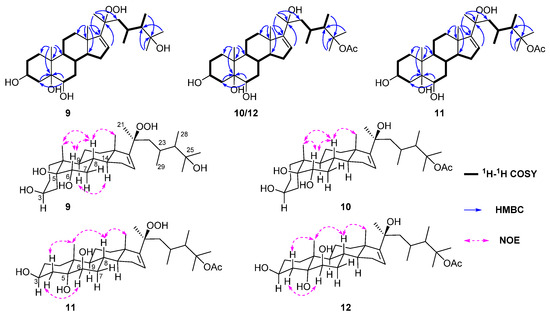
Figure 7.
The 1H–1H COSY, selected key HMBC and NOESY correlations of compounds 9–12.
The relative configuration of 9 was established mainly by analysis of the NOESY correlations. As depicted in Figure 7, it was found that the NOE interactions displayed by both H3-18/H-8, H3-19/H-8, H3-19/H-6 and H-6/H-8, assuming the β-orientation of H3-19, H-6, H-8 and H3-18. Moreover, the NOESY correlation of H-9/H-14 assigned the α-orientation of H-9 and H-14. Further, the chemical shifts of C-20, C-21, C-22, C-23, C-28 and C-29 on the side chain are similar to that of 16, suggested the same relative configuration of the chair centers on the side chain. In addition, the stereochemistry of C-5 and C-6 was assigned to be 5S*, 6S* by the comparison of chemical shifts of C-5 (δC 78.4) and C-6 (δC 73.2) with the model known compound 5β-cholestane-3β,5,6α-triol, which was previously isolated from the soft coral Sinularia sp. [28,29]. Consequently, the relative configuration of 9 was determined. Furthermore, based on the biogenetic consideration of the biosynthetic pathway of steroids, Me-18 and Me-19 should be positioned on the β-orientation; thus, the absolute configuration of 9 was elucidated as shown in Figure 1.
Lobocaloid B (10) was isolated as a white powder with the molecular formula of C31H52O6 on the basis of the HRESIMS ion peak at m/z 543.3655 [M + Na]+ (calcd. for C31H52O6Na, 543.3656), corresponding to six degrees of unsaturation. The 13C NMR and DEPT spectra of 10 displayed 31 carbon signals, including eight methyls, eight methylenes, eight methines (including one olefinic at δC 123.6) and seven quaternary carbons (including an olefinic at δC 161.2 and one carbonyl at δC 170.6), accounting for two out of six degrees of unsaturation, thus requiring four extra rings in the molecule structure of 10. The 13C NMR data (Table 3) of 10 closely resembled that of michosterols A (16), suggesting that they were also structural analogues. In fact, the only difference between 10 and 16 appeared at C-20, where the hydroperoxyl group in 16 was substituted by a hydroxyl group in 10, in agreement with a 16 mass unit difference between their molecular weights. This assignment was supported by not only the carbon chemical shift of C-20 significantly upfield shifted from δC 85.6 ppm to δC 75.7 ppm, but also the chemical shift of the distinctive olefinic proton H-16 shifted from δH 5.70 (d, J = 2.0 Hz) to δH 5.49 (dd, J = 3.4, 1.5 Hz). The relative stereochemistry of 10 was determined by the analysis of NOE correlations (Figure 7) and by comparison of NMR spectroscopic data with those of model molecule sarcophytosterol, a known steroid isolated from the Dongsha atoll soft coral Lobophytum sarcophytoides, whose structure has been unambiguously determined by X-ray diffraction analysis [30]. On the basis of the above findings, the structure of compound 10 was determined as shown in Figure 1.
The molecular formula of lobocaloid C (11) was the same as michosterols A (16), which was determined by HRESIMS ion peak at m/z 559.3609 [M + Na]+ (calcd. for C31H52O7Na, 559.3605). The proton and carbon resonances of 11 showed a high degree of similarity to those of 16. By comparison of the 1H and 13C NMR data (Table 4) of 11 and 16, the differences were found in the chemical shifts of carbons in rings A and B [C-1 (δC 32.3), C-2 (δC 31.0), C-4 (δC 40.8), C-5 (δC 76.3) and C-6 (δC 76.2) in 11 and C-1 (δC 25.2), C-2 (δC 27.7), C-4 (δC 30.0), C-5 (δC 78.1) and C-6 (δC 71.8) in 16)]. The following detailed analysis of 1H–1H COSY and HMBC correlations assigned the planar structure of 11, the same as 16, which suggested that 11 was the isomer of 16. Literature checking revealed that the NMR data of rings A and B in 11 were strongly reminiscent of the known compound 23,24-dimethylcholest-16-ene-3β,5α,6β,11α,20(R)-pentol-3-monoacetate [31], indicating that the rings’ structures were identical. Thus, the absolute stereochemistry of C-3, C-5, and C-6 in 11 was speculatively assigned as 3S, 5R, 6R.

Table 4.
1H (600 MHz) and 13C (150 MHz) NMR data of compounds 11 and 12 in CDCl3.
Lobocaloid D (12), which was obtained as a white powder, gave the molecular formula C31H52O6 on the basis of its HRESIMS ion peak at m/z 543.3653 [M + Na]+ (calcd. for C31H52O6Na, 543.3656), 16 mass units less than that of 11. A comparison of the NMR data of 12 with 11 (Table 4), revealed that they were structural analogues, with the only difference being the presence of a hydroxyl group substituted at C-20 on the side chain of 12 instead of a hydroperoxyl group in 11, in agreement with the 16 mass unit difference between compounds 11 and 12. The hydroxyl group was substituted at C-20, as evidenced by the observation of the upfield shifting of C-20 from δC 86.1 in 11 to δC 75.8 in 12. Similarly, the relative configuration of 12 was determined by analyzing NOE correlations and comparing its NMR data with those of compounds 10 and 11. As mentioned above, the structure of 12 was assigned as shown in Figure 1.
Compound 15 was readily identified as lobophytrol B, a capnosane-type diterpenoid previously reported to be isolated from Lobophytum sp. by our group [23]. By comparing the nuclear magnetic and optical rotation data, they proved to be exactly the same. In this study, the suitable crystals of 15 were eventually obtained, and they were then sent for X-ray crystallographic analysis using Cu Ka radiation (λ = 1.54178 Å). Analysis of the X-ray data unambiguously determined the planar structure and absolute configuration of 15 with the Flack parameter of 0.12 (7) (CCDC 2290866). Surprisingly, the X-ray result disclosed that the correct structure of lobophytrol B is 15a, instead of 15 (Figure 8). Compared to the mass spectrum, the molecular weight is 18 more than before, probably due to the presence of different molecular fragmentation peaks. We carefully and analyzed in depth the data to determine why the structure of 15 was incorrectly assigned, realizing that the error was triggered by the chemical shift of carbon substituted by the hydroxyl group and the same oxygen ring established at positions C-8 and C-12, as well as the existence of various molecular fragment peaks in the mass spectrum. Careful re-examination of the HRESIMS spectrum revealed wrong identification of the molecular ion peak at m/z HREIMS 363.2517 [M + Na]+ (calcd for C20H36O4Na, 363.2506), while the cluster of quasi-molecular ion peaks centered at m/z 323.2581 [M + H]+ (calcd for C20H35O3, 323.2581) was overlooked (Figure S10.1).
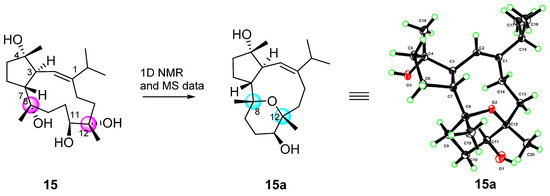
Figure 8.
Revised structure (15a) and originally structure of lobophytrol B (15) (Carbon atoms are represented by black ellipsoids, oxygen atoms are represented by red ellipsoids, and hydrogen atoms are represented by green spheres).
In the in vitro bioassay, the isolated compounds were tested for their antibacterial, cytotoxic and anti-inflammatory effects. In the antibacterial bioassays (Table 5), compound 2 showed moderate antibacterial activities against the fish pathogenic bacteria Streptococcus parauberis KSP28 (MIC 8.7 μg/mL) and Phoyobacterium damselae FP2244 (MIC 17.3 μg/mL). Compounds 7–9 showed weak antibacterial activities against S. parauberis KSP28 (MIC 30.4, 32.2, 49.4 μg/mL) and P. damselae FP2244 (MIC 30.4, 16.1, 49.4 μg/mL). All the steroids exhibited antibacterial activities against S. parauberis KSP28 with MIC values ranging from 12.3 to 53.6 µg/mL. Furthermore, compounds 10 and 13 exhibited significant antibacterial activities against a variety of strains; compound 13 especially displayed potent inhibitory activity against P. damselae FP2244, S. parauberis SPOF3K and S. agalactiae WR10 with MIC value of 6.2 µg/mL, 12.3 µg/mL and 12.3 µg/mL, respectively. Furthermore, compound 13 showed the growth inhibitory activities against the vancomycin-resistant Enterococcus faecium G1 and G8 with the MIC values of 12.3 μg/mL and 12.3 μg/mL, respectively, comparable with that of positive control levofloxacin hydrochloride (MIC > 39.78 µg/mL), ampicillin sodium (MIC > 37.14 µg/mL) and vancomycin hydrochloride (MIC > 297 µg/mL and 74.25 µg/mL).

Table 5.
The MIC values (μg/mL) of antibacterial bioassays of compounds 2 and 7–14.
In hemolytic activity, the results showed that the hemolytic activity of S. aureus treated with compounds 1–4, 6–8 and 13–15 were obviously reduced when compared with the control (without compound treatment). In particular, the hemolysis percentage of compound 2, 7 and 14 test groups reached about 35.7%, 42.2% and 39.1% (Figure 9). These results suggest that compounds 2, 7 and 14 have a strong inhibitory effect on the hemolysin production of S. aureus. Furthermore, in the pyocyanin quantitation assay experiment (Figure 10), compounds 8–12 have medium inhibition effects on the pyocyanin production in P. aeruginosa, compared with the control (without compound treatment).
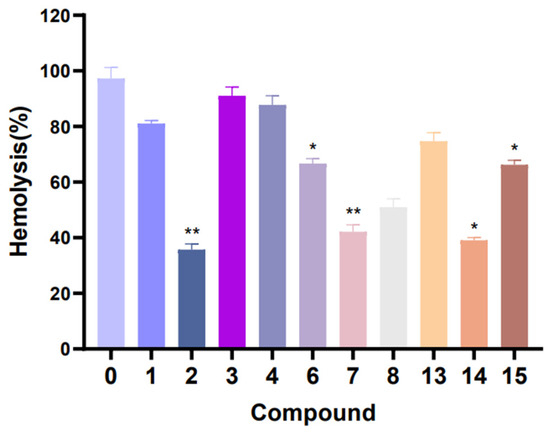
Figure 9.
Efficacy of compounds 1–4, 6–8 and 13–15 in inhibiting the hemolytic activity of S. aureus. ** p < 0.01, * p < 0.05. The assays were independently repeated at least three times.

Figure 10.
Efficacy of compounds 1, 3–4 and 6–15 in the pyocyanin production of P. aeruginosa. ** p < 0.01, * p < 0.05. The assays were independently repeated at least three times.
3. Materials and Methods
3.1. General Experimental Procedures
Melting points were measured on an X-4 digital micro melting point apparatus. Optical rotations were measured on a Perkin-Elmer 241MC polarimeter (PerkinElner, Fremont, CA, USA). IR spectra were measured on a Nicolet 6700 spectrometer (Thermo Scientific, Waltham, MA, USA), and peaks are reported in cm−1. NMR spectra were measured in CDCl3 with a Bruker DRX 400, 500, 600 and 800 MHz spectrometer (Bruker Biospin AG, Fällanden, Germany). Chemical shifts are reported in parts per million (δ) in CDCl3 (δH reported referred to CHCl3 at 7.26 ppm; δC reported referred to CDCl3 at 77.2 ppm), and coupling constants (J) are expressed in Hz. HRESIMS spectra were recorded on an Agilent 1290-6545 UHPLC-QTOF mass spectrometer. Commercial silica gel (Qingdao Haiyang Chemical Group Co., Ltd., Qingdao, China, 200–300 and 300–400 mesh) and Sephadex LH-20 gel (Amersham Biosciences, Amersham, UK) were used for column chromatography. Precoated silica gel plates (Yan Tai Zi Fu Chemical Group Co., Yantai, China, G60 F-254) were used for analytical TLC. Reversed-phase (RP) HPLC was performed on an Agilent 1260 series liquid chromatography equipped with a DAD G1315D detector at 210 and 254 nm. A semi-preparative ODS-HG-5 column [5 µm, 250 × 9.4 mm] was employed for the purifications. All solvents used for CC and HPLC were of analytical grade (Shanghai Chemical Reagents Co., Ltd., Shanghai, China) and chromatographic grade (Dikma Technologies Inc., Foothill Ranch, CA, USA), respectively. X-ray crystallographic analysis was carried out on a Bruker D8 Venture diffractometer with Cu Kα radiation (λ = 1.54178 Å) at 100 K. The collected data integration and reduction were processed with SAINT V8.37A software, and multi-scan absorption corrections were performed using the SADABS program. The structure was solved with the SHELXT structure solution program using intrinsic phasing and refined with the SHELXL refinement package using least-squares minimization. Copies of these data can be obtained free of charge via www.ccdc.cam.ac.uk. or from the Cambridge Crystallographic Data Centre, 12 Union Road, Cambridge CB21EZ, UK. [Fax: (+44) 1223-336-033. E-mail: deposit@ccdc.cam.ac.uk].
3.2. Animal Materials
Specimens of L. catalai, identified by Prof. Xiu-Bao Li from Hainan University, were collected by scuba along the coast off Yalong Bay (18°15′ N, 109°30′ E), Hainan Province, China, in 2006, at a depth of −15 m. A voucher specimen (YAL-65) was deposited and is available for inspection at the Bohai Rim Advanced Research Institute for Drug Discovery.
3.3. Extraction and Isolation
The frozen animals (260.5 g, dry weight after extraction) were cut into pieces and extracted exhaustively with acetone at room temperature (2.0 L × 4). The organic extract was evaporated to give a brown residue, which was then partitioned between Et2O and H2O. The Et2O solution was evaporated to give a dark brown residue (4.0 g). The obtained residue was subjected to gradient silica gel (200–300 mesh) column chromatography (CC) [Et2O/petroleum ether (PE) 0→100%] and yielded nine fractions (Fr. 1–9). Fr. 2 was divided into three subfractions (Fr. 2A–2C) by Sephadex LH-20 CC (PE/CH2Cl2/MeOH, 2:1:1). Following two-stage purification including Sephadex LH-20 CC (CH2Cl2, 100%) and silica gel CC (300–400 mesh, PE/Et2O 100:1→10:1), the subfraction Fr. 2C13 was purified by semi-preparative HPLC (MeCN, 100%, 3.0 mL/min) and analytical HPLC (MeOH/H2O, 80:20, 1.0 mL/min) to yield compounds 1 (2.0 mg, tR = 16.4 min), 2 (0.3 mg, tR = 18.4 min) and 4 (1.0 mg, tR = 15.3 min), respectively. Fr. 6 was split by Sephadex LH-20 CC (PE/CH2Cl2/MeOH, 2:1:1) to give two subfractions (Fr. 6A and Fr. 6B). Next, Fr. 6B was purified by Sephadex LH-20 CC (CH2Cl2, 100%), yielding subfraction Fr. 6BA. Final purification of Fra. 6BA was achieved by semi-preparative HPLC (MeOH/H2O, 80:20, 2.8 mL/min) to afford compounds 7 (0.5 mg, tR = 24.5 min) and 6 (1.0 mg, tR = 22.0 min) and the mixture of compounds 3 and 5. The mixture was further purified by analytical HPLC (MeCN/H2O, 60:40, 1.0 mL/min) to yield pure 3 (1.1 mg, tR = 13.0 min) and 5 (1.0 mg, tR = 14.6 min), respectively. Fr. 9 was subjected to a column of Sephadex LH-20 eluted with CH2Cl2/MeOH, 1:1, to yield two subfractions (Fr. 9A and 9B). Fr. 9A was first split by Sephadex LH-20 column chromatography (PE/CH2Cl2/MeOH, 2:1:1) to give five subfractions (Fr. 9AA–Fr. 9AE). Fr. 9AE was purified by RP-HPLC (MeCN/H2O, 60:40, 3.0 mL/min), yielding a subfraction (Fr. 9AEC, tR = 8.0 min). Since there are two points observed on the thin-layer chromatography (TLC), Fr. 9AEC was purified by silica gel CC (300–400 mesh, CH2Cl2/MeOH, 96:4) to give compounds 12 (1.0 mg) and 14 (0.5 mg). Fr. 9AD was purified with silica gel CC (300–400 mesh, Et2O/PE, 1:1), followed by semi-preparative HPLC (MeCN/H2O, 60:40, 3.0 mL/min) to afford 13 (5.4mg, tR = 2.1 min), 11 (3.2mg, tR = 8.8 min) and fraction 9ADFG (tR = 13.7min). In a similar manner, Fr. 9ADFG was purified by silica gel CC (300–400 mesh, CH2Cl2/MeOH, 98:2) to give compound 10 (2.6 mg). Moreover, compound 9 (2.7 mg, tR = 7.3 min) was obtained from Fr. 9B through Sephadex LH-20 CC (PE/CH2Cl2/MeOH, 2:1:1) followed by RP-HPLC (MeCN/H2O, 60:40, 3.0 mL/min), while compound 15 (2.7 mg, tR = 7.3 min) was obtained from the Fr. 9B through Sephadex LH-20 CC (PE/CH2Cl2/MeOH, 2:1:1), silica gel CC (200–300 mesh, Et2O/PE 50%→100%), followed by RP-HPLC (MeCN/H2O, 60:40, 3.0 mL/min).
3.3.1. Lobocaline A (1)
3.3.2. Lobocaline B (2)
3.3.3. Lobocaline C (3)
3.3.4. Lobocaline D (4)
3.3.5. Lobocaline E (5)
3.3.6. Lobocaloid A (9)
White amorphous powder, +9.8 (c 0.27, MeOH); IR (KBr): νmax 3436, 2929, 2871, 1375, 1089, 1050 cm−1; For 1H and 13C NMR spectroscopic data, see Table 3; HRESIMS m/z 517.3504 [M + Na]+ (calcd. for C29H50O6Na, 517.35).
3.3.7. Lobocaloid B (10)
White amorphous powder, −8.3 (c 0.26, MeOH); IR (KBr): νmax 3444, 2930, 1730, 1369, 1260, 1050, 800 cm−1; For 1H and 13C NMR spectroscopic data, see Table 3; HRESIMS m/z 543.3655 [M + Na]+ (calcd. for C31H52O6Na, 543.3656).
3.3.8. Lobocaloid C (11)
White amorphous powder, −16.7 (c 0.32, MeOH); IR (KBr): νmax 3444, 2931, 2864, 1374, 1030 cm−1; For 1H and 13C NMR spectroscopic data, see Table 4; HRESIMS m/z 559.3609 [M + Na]+ (calcd. for C31H52O7Na, 559.3605).
3.3.9. Lobocaloid D (12)
White amorphous powder; −43.3 (c 0.10, MeOH); IR (KBr): νmax 3443, 2928, 2851, 1712, 1368, 1036 cm−1; For 1H and 13C NMR spectroscopic data, see Table 4; HRESIMS m/z 543.3653 [M + Na]+ (calcd. for C31H52O6Na, 543.3656).
3.4. Calculation Section
Conformational search was performed by using the torsional sampling (MCMM) approach and OPLS_2005 force field within an energy window of 21 kJ/mol. Conformers above 1% Boltzmann populations were re-optimized at the B3LYP/6-311G(d,p) level with the IEFPCM solvent model for chloroform. Frequency analysis was also carried out to confirm that the re-optimized geometries were at the energy minima. Subsequently, NMR calculations were performed at the PCM/mPW1PW91/6-31G(d) level, as recommended for DP4+. NMR shielding constants were calculated using the GIAO method. Finally, shielding constants were averaged over the Boltzmann distribution obtained for each stereoisomer and correlated with the experimental data. ECD spectra were obtained by TDDFT calculations with the B3LYP/6-311G(d,p) level with the IEFPCM solvent model for CH3CN. At last, the Boltzmann-averaged ECD spectra of the compounds were obtained with SpecDis (Version 1.71).
3.5. Acetylation of Compound 6
Compound 6 (0.5 mg) was dissolved in dry pyridine (2.0 mL) and mixed with 50 mL of Ac2O. The mixtures were stirred at room temperature overnight, and the reaction was detected on the TLC by heating after spraying with vanillin H2SO4 reagent. The crude acetylated product, after evaporating the solvent in vacuo, was purified by silica gel CC (petroleum ether/ether, 9:1) to afford a colorless crystal compound 1a (0.5 mg, 87% yield), which was identical to the natural sample of 1 in all respects (Figure S1.10).
3.6. X-ray Crystallographic Analysis for Compounds 1 and 15a
Lobocaline A (1): colorless crystals, m.p. 68.9–71.6 °C; monoclinic, 2(C22H34O3), Mr = 692.98, crystal size: 0.11 × 0.05 × 0.04 mm3, space group P21, a = 10.6135(3) Å, b = 16.2226(5) Å, c = 11.8888(4) Å, V = 2044.73(11) Å3, Z = 2, ρcalc = 1.126 g/cm3, F (000) = 760.0. Independent reflections: 7619 with Rint = 0.0385, Rsigma = 0.0475. Final R1 = 0.0479, wR2 = 0.1174 reflections with I ≥ 2σ (I), R1 = 0.0523 (wR2 = 0.1215) for all unique data, Flack parameter: 0.00(10). The crystals of 1 were recrystallized from MeOH at room temperature. Crystallographic data for 1 were deposited at the Cambridge Crystallographic Data Centre (Deposition nos. CCDC 2290865).
Lobophytrol B (15a): colorless crystals, m.p. 119.1–177.0 °C; monoclinic, C20H36O4, Mr = 340.49, crystal size 0.15 × 0.08 × 0.05 mm3, space group I4, a = 14.6887(3) Å, b = 14.6887(3) Å, c = 37.2232(11) Å, V = 8031.2(4) Å3, Z = 16, ρcalc = 1.126 g/cm3, F(000) = 3008.0, 57940 collected reflections, 8240 independent reflections (Rint = 0.0620, Rsigma = 0.0327), final R1 = 0.0399 (wR2 = 0.1022) reflections with I ≥ 2σ (I), R1 = 0.0431, wR2 = 0.1051 for all unique data, Flack parameter: 0.12(7). The crystals of 15a were crystallized from acetone at room temperature. Crystallographic data for 15a were deposited at the Cambridge Crystallographic Data Centre (Deposition nos. CCDC 2290866).
3.7. Antibacterial Activity Bioassays
The strains Streptococcus parauberis KSP28, Streptococcus parauberis SPOF3K, Phoyoba cteriumdamselae FP2244, Aeromonas salmonicida AS42, Photobacterium halotolerans LMG 22194T, Enterococcus faecium 5270 MDR8 and Lactococcus garvieae FP MP5245 were provided by National Fisheries Research & Development Institute, Korea. The vancomycin-resistant Enterococcus faecium bacteria G1, G4, G7, G8 and G13 were provided by Ruijin Hospital, Shanghai Jiao Tong University School of Medicine. The strain Streptococcus agalactiae WR10 and Edwardsiella piscicida TH1 were provided by Chinese Academy of Tropical Agricultural Sciences. The MIC values for all antimicrobial agents were measured by the 96-well micro-dilution method. Mueller–Hinton II broth (cation-adjusted, BD 212322) was used for MIC value determination. Generally, compounds were dissolved with DMSO to 20 mM as stock solutions. All samples were diluted with culture broth to 500 µM as the initial concentration. Further 1:2 serial dilutions were performed by addition of culture broth to reach concentrations ranging from 500 µM to 0.24 µM. A total of 100 µL of each dilution was distributed in 96-well plates, as well as sterile controls, growth controls (containing culture broth plus DMSO, without compounds) and positive controls (containing culture broth plus control antibiotics, such as tetracycline). Each test and growth control well was inoculated with 5 µL of an exponential-phase bacterial suspension (about 105 CFU/well). The 96-well plates were incubated at 37 ℃ for 24 h. MIC values of these compounds were defined as the lowest concentration to inhibit the bacterial growth completely. All MIC values were interpreted according to recommendations of the Clinical and Laboratory Standards Institute (CLSI).
3.8. Antihemolytic Activity Bioassays
Blood was collected from the eye sockets of SD rats and stood for 30 to 60 min. After centrifugation (800 rpm, 5 min), the red blood cells were cleaned twice with 0.9% normal saline and then added to create a 4% red blood cells suspension. S. aureus suspension was incubated with compounds (100 µM) in a centrifuge tube for 12 h at 37 ℃. After centrifugation (6000 rpm, 15 min), 500 µL of the supernatant was taken from each tube, filtered by a 0.2 μm filter membrane and incubated with 500 µL of freshly red blood cells suspension at 37 ℃ for 2 h. The incubation of S. aureus and red blood cells suspension was used as the positive control, and the incubation of LB liquid medium and red blood cells suspension served as the negative control. After centrifugation (800 rpm, 5 min), the absorbance of supernatants at 540 nm was examined. The percentage of hemolysis value was calculated by comparing it with the positive control (100% hemolysis).
3.9. Pyocyanin Quantitation Assay
The P. aeruginosa strain was mixed with the compounds (100 µM) at 37 ℃ and 140 rpm/min for 24 h, and the supernatant was mixed with 1 mL chloroform. Then, the lower chloroform phase was mixed with 200 µL of 0.2 N HCl; after shaking and centrifugal (4500 rpm, 10 min), the color layer was removed and measured at 520 nm. Concentrations, expressed as micrograms of pyocyanin produced per milliliter of culture supernatant, were determined by multiplying the optical density at 520 nm (OD520) by 17.072.
4. Conclusions
In summary, five new cembrane-type diterpenes lobocalines A–E (1–5) and four new steroids lobocaloids A–D (9–12), along with six known analogues (6–8 and 13–15), were isolated and characterized from the soft coral L. catalai collected off Yalong Bay of the South China Sea. Structurally, all the isolated new cembrane-type diterpenes have hydroxyl or acetoxy groups substituted at C-5, C-6 or C-7. All the steroids possessed the hydroxyl groups at C-3, C-5 and C-6, and the stereotypes of hydroxyl groups (3β, 5β, 6α or 3β, 5α, 6β) are significantly different in 9–14. It is worth noting that the structure of known compound 15 has been revised by the X-ray diffraction analysis in this study.
In the bioassays, compounds 2 and 7–14 showed antibacterial activities against the fish pathogenic bacteria S. parauberis KSP28 with MIC values ranging from 12.3 to 53.6 µg/mL. Compound 13 displayed potent inhibitory activity against P. damselae FP2244 with MIC value of 6.2 µg/mL. Compounds 10 (3β, 5β, 6α) and 12 (3β, 5α, 6β) have different configurations, and the antibacterial activity of compound 10 was stronger than that of 12, suggested the importance of stereochemistry for bioactivity. Further study should be conducted to explore the effect of different cholestane-3,5,6-triols configurations (3β, 5β, 6α or 3β, 5α, 6β) on antibacterial activities. These new findings imply that these isolated compounds could be developed as new chemotypes of lead agents against fish pathogens, which may have a beneficial effect on fish health in the future. In addition, the findings reveal that compounds 2, 7 and 14 have remarkable inhibition effects on the virulence of S. aureus, supporting their potential as the natural antimicrobial agent to combat S. aureus.
Supplementary Materials
The following supporting information can be downloaded at: https://www.mdpi.com/article/10.3390/md22010050/s1. X-ray crystallographic analyses data of compounds 1 and 15a, NMR, HR-ESIMS and IR data of compounds 1–5 and 9–12, CD and UV data of compounds 1–5, HR-ESIMS data of compound 15a, QM-NMR and TDDFT-ECD calculation data of compound 3–5.
Author Contributions
Conceptualization, S.-W.L., H.W. and Y.-W.G.; methodology, M.-Z.S., S.-W.L., H.W. and Y.-W.G.; validation, S.-H.Z., Y.-M.C. and M.-Z.S.; formal analysis, S.-H.Z. and Y.-M.C.; investigation, S.-H.Z. and Y.-M.C.; resources, L.-G.Y.; data curation, S.-H.Z. and Y.-M.C.; writing—original draft preparation, S.-H.Z.; writing—review and editing, S.-W.L. and Y.-W.G.; supervision, H.W. and Y.-W.G.; project administration, Y.-W.G.; funding acquisition, H.W. and Y.-W.G. All authors have read and agreed to the published version of the manuscript.
Funding
This work was financially supported by the National Natural Science Foundation of China (NSFC) (No. 81991521, 41876194), Shandong Laboratory Program (No. SYS202205).
Institutional Review Board Statement
Not applicable.
Data Availability Statement
Data are contained within the article or Supplementary Materials.
Acknowledgments
The authors thank X.-B. Li from Hainan University for the taxonomic identification of the soft coral material. The authors thank Shanghai Supercomputer Center for the computing services.
Conflicts of Interest
The authors declare no conflicts of interest.
References
- Chi, L.P.; Liu, D.; Li, X.M.; Wan, Y.P.; Wang, B.G.; Li, X. Aspertides A-E: Antimicrobial pentadepsipeptides with a unique p-Methoxycinnamoyl amide group from the marine isolates Aspergillus tamarii MA-21 and Aspergillus insuetus SD-512. J. Agric. Food Chem. 2023, 71, 13316–13324. [Google Scholar] [CrossRef]
- Guo, S.Y.; Zhang, Z.Y.; Guo, L. Antibacterial molecules from marine microorganisms against aquatic pathogens: A Concise Re view. Mar. Drugs 2022, 20, 230. [Google Scholar] [CrossRef] [PubMed]
- Li, S.W.; Yu, D.D.; Su, M.Z.; Yao, L.G.; Wang, H.; Liu, X.T.; Guo, Y.W. Ocellatuspyrones A–G, new antibacterial polypropionates from the Chinese mollusk ocellatus. Mar. Life Sci. Technol. 2023, 5, 373–386. [Google Scholar] [CrossRef]
- Gao, K.; Su, B.; Dai, J.; Li, P.; Wang, R.; Yang, X. Anti-biofilm and anti-hemolysis activities of 10-Hydroxy-2-decenoic acid against Staphylococcus aureus. Molecules 2022, 27, 1485. [Google Scholar] [CrossRef] [PubMed]
- McDermott, C.; Chess-Williams, R.; Grant, G.D.; Perkins, A.V.; McFarland, A.J.; Davey, A.K.; Anoopkumar-Dukie, S. Effects of Pseudomonas aeruginosa virulence factor pyocyanin on human urothelial cell function and viability. J. Urol. 2012, 187, 1087–1093. [Google Scholar] [CrossRef] [PubMed]
- Carroll, A.R.; Copp, B.R.; Davis, R.A.; Keyzers, R.A.; Prinsep, M.R. Marine natural products. Nat. Prod. Rep. 2020, 37, 175–223. [Google Scholar] [CrossRef] [PubMed]
- Elkhouly, H.B.; Attia, E.Z.; Khedr, A.I.M.; Samy, M.N.; Fouad, M.A. Recent updates on Sinularia soft coral. Mini-Rev. Med. Chem. 2022, 22, 1152–1196. [Google Scholar] [CrossRef] [PubMed]
- He, X.; Yan, S.; Zeng, L.; Su, J. Studies on the secondary metabolite of the soft coral Lobophytum sp.(II). Acta Sci. Nat. Univ. Sunyatseni 2005, 44, 113–115. [Google Scholar]
- Sarma, N.S.; Krishna, M.S.; Pasha, S.G.; Rao, T.S.P.; Venkateswarlu, Y.; Parameswaran, P.S. Marine metabolites: The Sterols of Soft Coral. Chem. Rev. 2009, 109, 2803–2828. [Google Scholar] [CrossRef]
- Yin, S.W.; Shi, Y.P.; Li, X.M.; Wang, B.G. A novel hydroperoxyl substituted cembranolide diterpene from marine soft coral Lobophytum crassum. Chin. Chem. Lett. 2005, 16, 1489–1491. [Google Scholar]
- Li, S.W.; Cuadrado, C.; Yao, L.G.; Daranas, A.H.; Guo, Y.W. Quantum mechanical-NMR-Aided configuration and confor mation of two unreported macrocycles isolated from the soft coral Lobophytum sp.: Energy Calculations versus Coupling Constants. Org. Lett. 2020, 22, 4093–4096. [Google Scholar] [CrossRef] [PubMed]
- Liu, J.; Gu, Y.C.; Su, M.Z.; Guo, Y.W. Chemistry and bioactivity of secondary metabolites from South China Sea marine fauna and flora: Recent research advances and perspective. Acta Pharmacol. Sin. 2022, 43, 3062–3079. [Google Scholar] [CrossRef]
- Burkhardt, I.; Rond, T.; Chen, P.Y.-T.; Moore, B.S. Ancient plant-like terpene biosynthesis in corals. Nat. Chem. Biol. 2022, 18, 664–669. [Google Scholar] [CrossRef] [PubMed]
- Scesa, P.D.; Lin, Z.; Schmidt, E.W. Ancient defensive terpene biosynthetic gene clusters in the soft corals. Nat. Chem. Biol. 2022, 18, 659–663. [Google Scholar] [CrossRef] [PubMed]
- Anjaneyulu, A.S.R.; Rao, N.S.K.; Sagar, K.S. Two new cembranoids from the soft coral Lobophytum catalai Tixier-Durivault of the Andaman and Nicobar Islands. Indian J. Chem. B 1998, 37, 267–274. [Google Scholar] [CrossRef]
- Anjaneyulu, A.S.R.; Rao, N.S.K.; Venugopal, M. A novel furanosesquiterpenoid from the soft coral Lobophytum catalai Tixier-Durivault of the Andaman and Nicobar Islands. Indian J. Chem. B 1996, 35, 1001–1003. [Google Scholar]
- Zhang, J.; Ma, H.; Jin, S.; Liu, X.; Li, L.; Liu, Z.; Li, G.; Li, P. Seven new lobane diterpenoids from the soft coral Lobophytum catalai. Mar. Drugs 2023, 21, 223. [Google Scholar] [CrossRef] [PubMed]
- Wan, Y.; Zeng, Z.; Zeng, L. Study on the steroids from the soft coral Lobophytum catalai. Acta Sci. Nat. Univ. Sunyatsenin 1996, 35 (Suppl. 2), 171–172. [Google Scholar]
- Shen, S.-M.; Appendino, G.; Guo, Y.-W. Pitfalls in the structural elucidation of small molecules. A critical analysis of a decade of structural misassignments of marine natural products. Nat. Prod. Rep. 2022, 39, 1803–1832. [Google Scholar] [CrossRef]
- Yu, J.-D.; Su, M.-Z.; Gu, Y.-C.; Yu, D.-D.; Yao, L.-G.; Shen, S.-M.; Guo, Y.-W.; Wang, H. Two new cembranoids from the Chinese soft coral Sarcophyton boettgeri. Chem. Biodivers. 2023, 20, e202300662. [Google Scholar] [CrossRef]
- Duh, C.Y.; Hou, R.S. Cytotoxic cembranoids from the soft corals Sinularia gibberosa and Sarcophyton trocheliophorum. J. Nat. Prod. 1996, 59, 595–598. [Google Scholar] [CrossRef]
- Liang, L.-F.; Chen, W.-T.; Mollo, E.; Yao, L.-G.; Wang, H.-Y.; Xiao, W.; Guo, Y.-W. Sarcophytrols G–L, novel minor metabolic components from South China Sea soft coral Sarcophyton trocheliophorum MARENZELLER. Chem. Biodivers. 2017, 14, e1700079. [Google Scholar] [CrossRef] [PubMed]
- Yamada, Y.; Suzuki, S.; Iguchi, K.; Kikuchi, H.; Tsukitani, Y.; Horiai, H.; Nakanishi, H. Studies on marine natural-products. 2. New polyhydroxylated sterols from the soft coral Lobophytum-pauciflorum (ehrenberg). Chem. Pharm. Bull. 1980, 28, 473–478. [Google Scholar] [CrossRef]
- Zidan, S.A.H.; Abdelhamid, R.A.; Al-Hammady, M.; Fouad, M.A.; Matsunami, K.; Orabi, M.A.A. Cytotoxic polyhydroxy sterols from the Egyptian Red Sea soft coral Sarcophyton acutum. Fitoterapia 2020, 147, 104765. [Google Scholar] [CrossRef] [PubMed]
- Zhang, Q.; Li, X.W.; Yao, L.G.; Wu, B.; Guo, Y.W. Three new capnosane-type diterpenoids from the South China Sea soft coral Lobophytum sp. Fitoterapia 2019, 133, 70–74. [Google Scholar] [CrossRef]
- Subrahmanyam, C.; Rao, C.V.; Anjaneyulu, V.; Satyanarayana, P.; Rao, P.V.S.; Ward, R.S.; Pelter, A. New diterpenes from a new species of Lobophytum soft coral of the South Andaman Coast. Tetrahedron 1992, 48, 3111–3120. [Google Scholar] [CrossRef]
- Huang, C.Y.; Tseng, W.R.; Ahmed, A.F.; Chiang, P.L.; Tai, C.J.; Hwang, T.L.; Dai, C.F.; Sheu, J.H. Anti-inflammatory polyoxygenated steroids from the soft coral Lobophytum michaelae. Mar. Drugs 2018, 16, 93. [Google Scholar] [CrossRef]
- Li, R.; Shao, C.-L.; Qi, X.; Li, X.-B.; Li, J.; Sun, L.-L.; Wang, C.-Y. Polyoxygenated sterols from the South China Sea soft coral Sinularia sp. Mar. Drugs 2012, 10, 1422–1432. [Google Scholar] [CrossRef]
- Zhao, K.; Wang, Y.; Han, L. 4,5-Epoxycholestane-3,6-diols: Templates for generating the full set of eight cholestane-3,5,6-triol stereoisomers in multigram scales, but not for a cholestane-3,4,6-triol. Steroids 2007, 72, 95–104. [Google Scholar] [CrossRef]
- Lu, Y.; Lin, Y.-C.; Wen, Z.-H.; Su, J.-H.; Sung, P.-J.; Hsu, C.-H.; Kuo, Y.-H.; Chiang, M.Y.; Dai, C.-F.; Sheu, J.-H. Steroid and cembranoids from the Dongsha atoll soft coral Lobophytum sarcophytoides. Tetrahedron 2010, 66, 7129–7135. [Google Scholar] [CrossRef]
- Bawakid, N.O.; Alarif, W.M.; Abdel-Lateff, A. Rare norisodinosterol derivatives from Xenia umbellata: Isolation and anti-proliferative activity. Open Chem. 2021, 19, 400–407. [Google Scholar] [CrossRef]
Disclaimer/Publisher’s Note: The statements, opinions and data contained in all publications are solely those of the individual author(s) and contributor(s) and not of MDPI and/or the editor(s). MDPI and/or the editor(s) disclaim responsibility for any injury to people or property resulting from any ideas, methods, instructions or products referred to in the content. |
© 2024 by the authors. Licensee MDPI, Basel, Switzerland. This article is an open access article distributed under the terms and conditions of the Creative Commons Attribution (CC BY) license (https://creativecommons.org/licenses/by/4.0/).